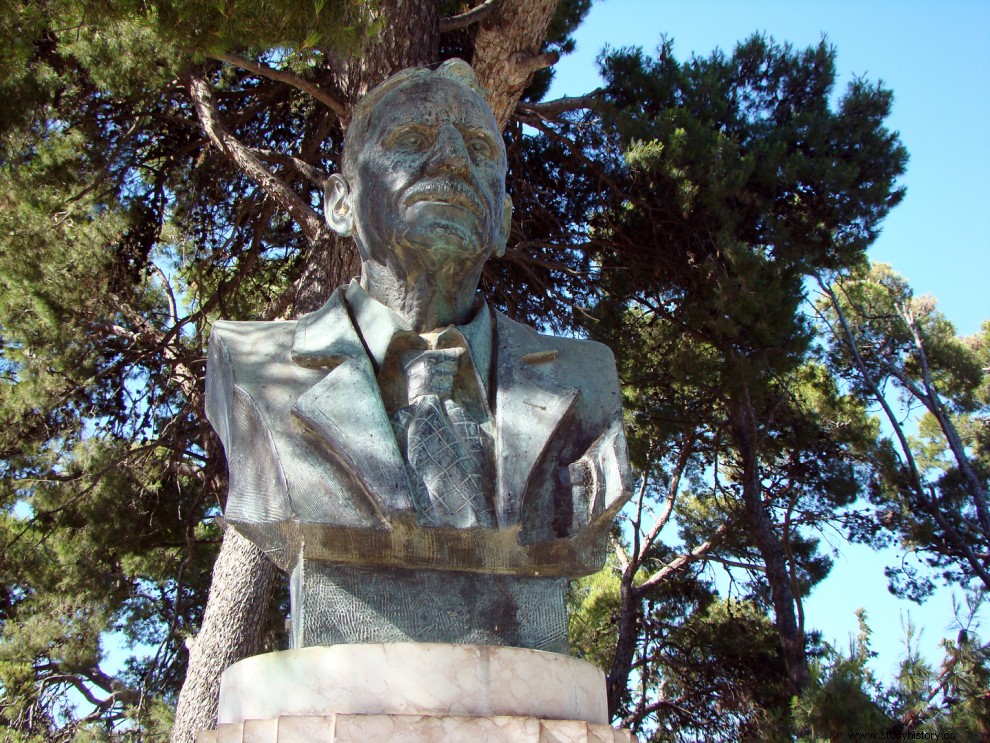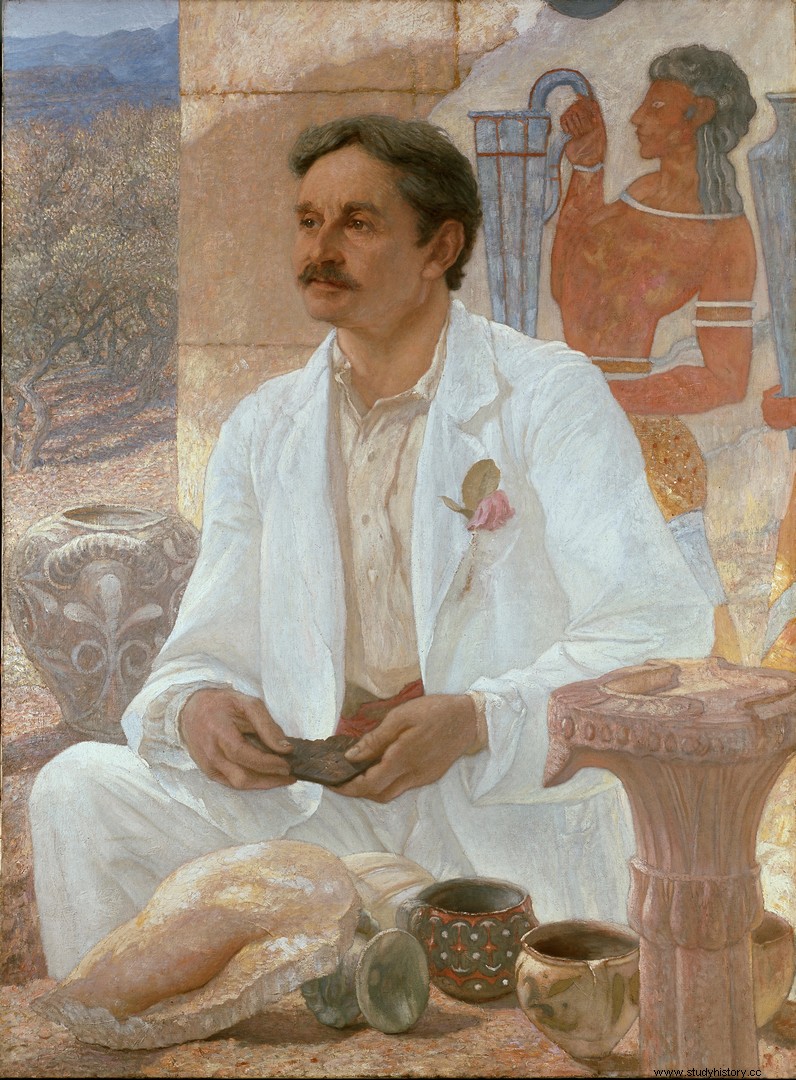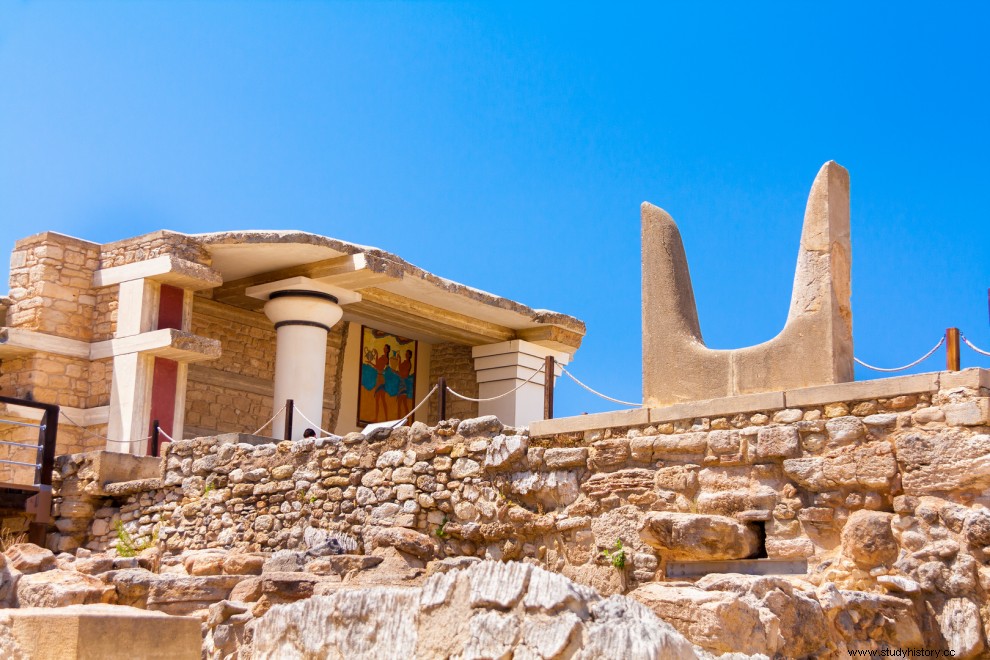Sunday 11 July marked the 80th anniversary of the death of Sir Arthur Evans (1851-1941), the man who "discovered" the Minoan Civilization and made the "palace" of Knossos famous throughout the world. Oops, Oops! What are the quotes for? Didn't Sir Arthur really discover the palace of Knossos, that gem of the extroverted and wonderful Minoan Civilization, the place where the mythical king Minos kept the terrible and terrible minotaur Asterius imprisoned in the infamous labyrinth? Um, not exactly, I mean...
Let's go, therefore, to put things a little in their place.
Starting, of course, with Arthur John Evans himself, who was born on July 8, 1851 in Nash Mills, Hertfordshire in eastern England. Eldest son of John Evans and (his first cousin) Harriet , Arthur and his four siblings grew up in an environment that on the one hand was full of tradition - thanks to the profitable family paper mill -, on the other hand he truly loved education, cultivation, and archeology in particular. Father Evans, in fact, was a great collector of ancient artifacts, a lover of geology, and an amateur archaeologist. Among us, some typographers argue that son Evans was also an amateur (archaeologist), since he never officially completed his modern studies History that began on June 9, 1870 in Oxford...

In any case, the paternal fortune and the family obsession with archeology were two parameters that largely determined Arthur's later brilliant career. Because, of course, it was the profits from the paper mill that financed the purchase of Cretan land, the excavations, the extravagant restorations, and his subsequent publications about Knossos.
The tours of a little spy
The same source of funding, however, also had the repeated trips made by the young Arthur Evans around Europe, roughly from the age of 20 to 35. Sometimes with his brother, Louis , and sometimes with his other brother, Norman , the delinquent student Arthur traveled to Austria, France, Scandinavia, Lapland, reached the Carpathians, and then began poking around the fringes of the crumbling Ottoman Empire. And wherever it was found, more and more something ancient was unearthed in solo bazaars, more and more a Roman remnant was identified in improvised excavations. He was undoubtedly intelligent, studious, and determined.
It should be made clear here the historical-social context in which such "missions" of discovery, rescue, and... rapid civilization of the somewhat more backward nations on the part of wealthy English flourished. Because it's not just that these guys could make such trips - it's that they really enjoyed it. We are, after all, in the middle of the Victorian Era, Great Britain is a world empire, its scientific discoveries are drastically changing the way of life, there is money... And there is also an insatiable longing for long trips, for sightseeing, for getting to know other places and more morals.
These other customs and their mysterious places had, in some way, been fixed on young Arthur's mind. From there he always returned to Bosnia-Herzegovina, for example, where the first organized uprisings against the Ottomans were already recorded. Convinced that the mere replacement of the Ottoman Empire by Austro-Hungary was no super-improvement for the Balkans, Evans wrote public letters openly in favor of the rebels and their independence (incidentally, at his funeral in 1941, the then Yugoslavia had sent an official mission honoring this ardent supporter of its independence). Soon after, Evans began working as the Balkans correspondent for the Manchester Guardian newspaper, and was also appointed secretary of the British Fund for Balkan Refugees.

In fact, during one of his trips to Bosnia in 1882, Evans was arrested by the Ottomans on charges of espionage. It wasn't true, of course, but Arthur had also had a hand, since in his various haggling with the Ottoman authorities he himself grandly invoked the Royal Navy, or high-ranking persons as his protectors... Pending trial, he was imprisoned for six weeks, but eventually the charge collapsed and Arthur Evans was deported. He returned to Oxford and his wife of four years, Margaret Freeman (1848-1893), became a curator at the Asmolean Museum in Oxford – and of course continued to travel incessantly to the places that interested him.
The Cretan adventure
It seems that Evans' special interest in Crete was sparked around 1883, when on his maiden trip to Athens he found and bought some ancient carved seal stones that had come from the island. Incidentally, during that same stay in Athens, the Evans couple had met with the Sliman couple. and the two "archaeologists" had exchanged opinions about Troy, ancient Mycenae, and other such buried and mythical places. Four more trips by Evans to Athens followed, and then came the death of Margaret (whom he loved dearly) in 1893, so a year later Arthur took the steamer to Heraklion.
It is important to think about the situation that prevailed in Crete at that time. We are four years before the declaration of the island's autonomy (1898) and the creation of the Cretan State under the high sovereignty of the Sultan. There is a financial mess, the skirmishes have not stopped, while a wire has already fallen about the "case of Knossos" among (mainly foreign) archaeologists. Among us, however, from long ago the farmers of Heraklion dug up the carved seal stones from the fields, to which they, in fact, attributed magical properties - they called them, let's say, "milk stones", because they believed that if a woman wore such a stone in the her breasts would let down more milk for her babies. On the other hand, the case of the wealthy Heraklion antiquarian, Minoas Kalokairinos was also known. , who in 1878 had carried out a mere 20-day excavation on the Tselepi Kefala hill to the south of Heraklion – where the "palace" of Knossos was to emerge – bringing to light ancient storehouses and some huge clay jars.
And while pioneers and archaeologists from France, Italy, Britain, Germany and the USA were competing, trying to capture the coveted Ottoman firman that would allow them to dig in Kefala, the ever astute Evans defeated them all, succeeding, on March 16 1900, to buy 20 acres of the later archaeological site of Knossos. With dad's money, of course-of course, but also with clever personal manipulations that essentially created a monopoly situation for his party in the area of Knossos.

The rest belongs, as is commonly said, to History. During the five-year period 1900-1905 Evans brought to light a very extensive, elaborate, well-equipped and beautifully decorated residential complex, which housed, among other things, wine presses, metalworking workshops, food stores, places of worship and much more. Also, among the many finds, Evans also excavated over 3,000 clay tablets written in Linear A and B.
The food
Good then. But where, after all, was Sir Arthur's fault? I mean, being rich, well-read, inquisitive, and well-heeled, and able to dig wherever he pleased was no great offense at the dawn of the 20th century. century, isn't it? It is – but it isn't. Let us see, in this case, some of the fouls that experts and (diploma) archaeologists accuse him of, from the 1970s onwards. Fouls, which make the lines between scientific interpretation and pure speculation very, very blurry.
1. Nowhere and in no source is the existing civilization that flourished in Crete between 3,000 and 1,450 BC, and which is mentioned by Homer and Strabo, referred to as "Minoan". The name is clearly Evans' invention. Because, he says, upon seeing the intricate (and often multi-story) layout of the excavated buildings and corridors, his mind immediately went to the labyrinth where, according to ancient Greek legend, King Minos of Crete kept the minotaur Asterios. Minos, minotaur, Minoan –elementary, dear!
2. In the palimpsest way that so many places of archaeological interest operate, beneath Evans' "Minoan" findings, which date from the Bronze Age, remnants of the Neolithic Period also emerged. The English antiquarian did little with these - it wasn't even funky...
3. That the excavation of Knossos is organized around a palace – namely, of the mythical king Minos – does not seem to emerge with certainty from anywhere. Simply, when Evans excavated the well-known stone vault he convinced himself that he had discovered the throne room.

4. Indeed, Evans' excavation – which continued after World War I until the mid-1930s – revealed sophisticated tools, pottery, fine jewelry, and of course wall paintings; with bulls, floral motifs, dolphins, with people doing vertical on the back of a bull (taurokathapsia), with ladies in robes, and scantily clad barefoot youths. How all this is composed into an incompetent, progressive, pacifist, matriarchal and out-hearted society, constituting the first advanced civilization of Europe, is at heart the beautified arbitrary creation of Evans and his publications.

5. Anyone who has been to Knossos has probably stared at its colorful frescoes. And yet:the elegant "Ladies in Blue", the athletic "Lily Prince", the magnificent flowers and the sitting griffin that adorn the Throne Room - all these colorful and improbable things that decorate the walls, after all - are, in in many ways, the work of the Englishman Piet de Jong and the Swiss Emile Guieron Elder and Newer . Namely, the specialized "excavation" painters recruited by Evans, in order to highlight, illustrate and, above all, complete the remains that the excavation had brought to light. As he notes in his forthcoming book "The Secret of Civilization" (Andrew Selkirk, "The Secret of Civilization"), the renowned English archaeologist Andrew Selkirk , "the resulting drawings are 10% ancient plaster and 90% Guilleron's [and de Jong] imagination based on Evans' ideas". Therefore, the Minoan frescoes are often paralleled with art nouveau.

6. And we end with the biggest blunder, which unfolded over the nearly 30 years during which Evans kept "improving" his Cretan discovery. We are talking about the use of concrete (Lina Mendoni, are you listening?). Often a face card, Sir Arthur resorted again and again to this material after the First World War, in an attempt to give a clearer shape to buildings, rooms and surroundings. As the American history teacher, Kathy Geer, sarcastically observes , in her book "Knossos and the Prophets of Modernism" (Cathy Gere, "Knossos and the Prophets of Modernism"), "the ancient palace [of Knossos] was fortunate to received the controversial distinction of being one of the first reinforced concrete buildings on the island.”
